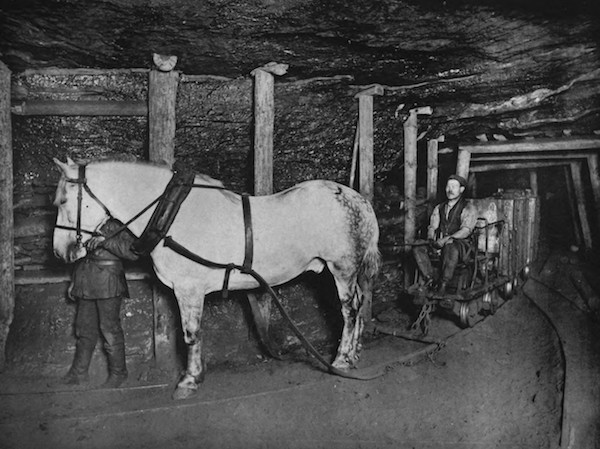
Förderung durch Pferde, 1894, Heinrich Börner
A horse is one of the most memorable characters in Germinal, Emile Zola’s classic novel of a French coal miner’s strike and of the very human struggle between capital and labor. The animal, named “Bataille,” has lived and worked in the mine, pulling ore carts, for more than ten years. For Bataille, the surface is remembered only faintly, when a strong wind carries the odor of the open air deep into the mine. Bataille’s ultimate death deep underground is a sad symbol of capital’s toll on human and nonhuman bodies.
Bataille, and the actual horses that lived and died like him, are an unexpected part of the history of energy. These animals provided labor crucial to the extraction of the energy source that dominates our world today: fossil fuels. Considering animals, and their place in the history of energy, provides a new perspective on human relationships with the nonhuman world. This brief essay considers two aspects of the relationship between animals and the history of energy: (1) animals as sources of labor; and (2) animals as sources of caloric energy (food).
Animals have been an important source of power in human history. Animal-pulled plows drove premodern agriculture and remain important in parts of the world today. Horses were once central to warfare, providing mobility and speed. As Ann Norton Green has argued, horses actually powered the processes of industrialization that would ultimately replace them.1 Similarly, in the days before railroad or truck transport, animals were vital to the distribution of agricultural products. A bushel of corn had to be carried to market, but cattle or pigs could walk themselves. Pigs in eastern Ohio and Pennsylvania were fattened on corn and then driven over mountains to eastern markets.2 During the 1880s, before railroads reached the Texas Panhandle, cattle walked themselves hundreds of miles to Kansas rail-towns.3
![From Kansas plains [...], Union Stock Yards [stockyards], Chicago, U.S.A.
From Kansas plains [...], Union Stock Yards [stockyards], Chicago, U.S.A.](images/specht2_600.png)
From Kansas plains, Union Stock Yards [stockyards], Chicago, U.S.A.
For humans, food is the most fundamental source of energy, and animals play a key role in processing indigestible plant matter (which is itself a form of energy created from the sun) into edible meat. On the nineteenth-century Great Plains, nomadic American Indian societies used horses to hunt bison, which were able to digest plains grasses and were a vital source of food (and other commodities).4 When the descendants of European people began to occupy the Plains—violently seizing the land from American Indian peoples—they created a similar system: ranchers on horseback cared for cattle that could transform plains grasses into edible meat. In both systems, grazing animals made marginal land productive.
Yet if we focus on energy, we see that though meat consumption is prevalent today, the place of animals in its production has changed radically. Industrialized animal husbandry requires a great deal of input energy, often derived from fossil fuels. Feedlots fatten animals with imported crops, and it takes several pounds of fodder to produce a pound of saleable meat. No longer are grazing animals a way to see returns from land that cannot be profitably farmed. Further, because worldwide increases in income track with increased in meat consumption, this problem is growing. Meat production today is a major contributor to climate change; understanding today’s energy challenges requires reexamining the relationship between humans and their food.5
As workers and as sources of food, animals have been an important part of the history of energy. Animal husbandry has evolved from a process productive of human energy—through the metabolization of grasses—to an energy intensive process, fundamentally changing the role of meat production and consumption in human society. By including animals in the history of energy, we see that a broad conception of energy is necessary to understand the human relationship with the nonhuman world.
Notes:
1 Ann Norton Greene, Horses at Work: Harnessing Power in Industrial America (Harvard University Press, 2009).
2 John C Hudson, Making the Corn Belt: A Geographical History of Middle-Western Agriculture (Bloomington: Indiana University Press, 1994).
3 Joshua Specht, “The Rise, Fall, and Rebirth of the Texas Longhorn: An Evolutionary History,” Environmental History, 2015, emv148.
4 Elliott West, The Contested Plains: Indians, Goldseekers, & the Rush to Colorado, New edition edition (Lawrence, Kan.: University Press of Kansas, 1998).
5 In addition to the energy-intensive nature of meat production, this affect on climate change is also the result of methane produced by cattle.
Joshua Specht is assistant professor of history at Monash University. He received his PhD from Harvard in 2015, and was a research associate of the Global History of Energy program at the Harvard Center for History and Economics from 2011 to 2015.
